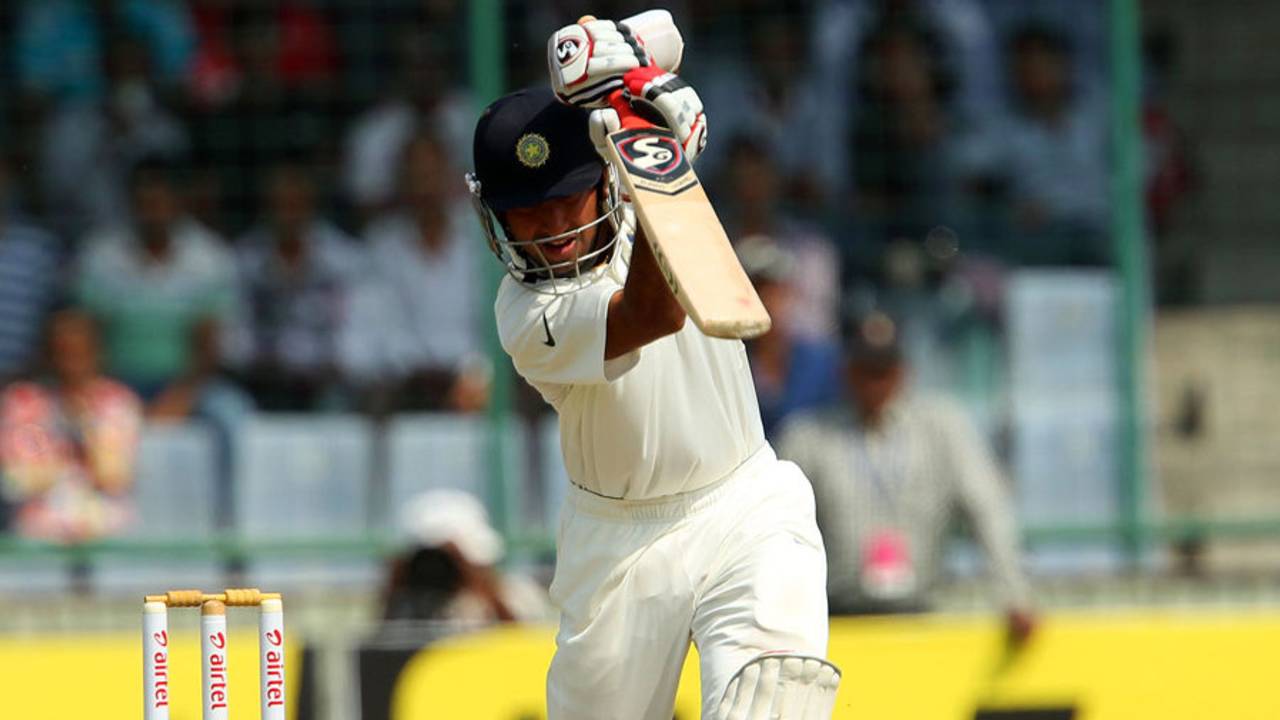To watch
Cheteshwar Pujara walk out to bat is to picture a knight preparing for a joust. His face is helmeted, even against a non-stop diet of spin bowling. There is that fabric-covered forearm protector as well, and the pre-ball ritual of raising his bat with both hands perpendicularly - probably to settle in on the right grip - adds to the theatre.
But his fights do not deal in instant gratification. Pujara is an even-tempered and methodical warrior, traits that were on display in
the Duleep Trophy final. He batted for nine hours to make his 10th first-class double-century. That does not mean he was slow. Pujara was unbeaten on 256 when India Blue declared on 693, and his strike rate was an eye-popping 70.52. The innings addressed two aspects of his batting that have been held against him recently - the pace at which he makes runs, and to a lesser extent, the pace at which he actually runs. It also made sure his side recovered handsomely after a bit of a bad start.
India Red had broken through with the first ball of the day, when Pradeep Sangwan got Dinesh Karthik to play one on to the stumps. Nathu Singh, at the other end, revved it up and, with a little help from the cracks on the pitch, made serious inquisition of the batsmen's technique.
While Sheldon Jackson, who eventually scored a hundred too, wasn't altogether comfortable in tackling Nathu, especially off a good length, Pujara almost always had the right response. The recurring image of the morning session was one of him striding forward and meeting the ball, rising off a length, high on the bat, or realising it was no threat to his stumps and leaving it alone. By fully committing to the front foot and keeping his hands soft to account for any sharp deviation or extra bounce, Pujara dissuaded Nathu from persisting with the tricky, in-between length, which can be dangerous on a slow pitch with variable bounce.
Ever since India's Test captain Virat Kohli mooted a five-bowler strategy, he has preferred having attacking batsmen who can, theoretically, ensure there is enough time to take 20 wickets. Pujara's strike-rate, along with a slight dip in form, was seen to be at odds with achieving this end. As a result Pujara found himself out of the XI in Sydney and in Fatullah last year and he also had to deal with being omitted for the St Lucia Test last month to accommodate Rohit Sharma.
Pujara, who had made 16 off 67 balls and 46 off 159 balls in his last two innings in the Caribbean, began the home season by scoring 166 at a strike-rate of almost 60 against India Green earlier this week. He went one better in this innings, reaching 50, 100 and 200 - not to mention his 10,000th first-class run as well - with boundaries.
In scoring at the rate he did, Pujara also stayed true to his batting template of initial caution before sustained acceleration. From 96 off 150 balls, he moved to 150 off 226 balls, and slowed down a touch to reach 201 off 303 balls before accelerating again.
There were signs typical of any Pujara knock - bottom-hand drives and cuts, little flicks off the spinners - but there was also something new. It has long been felt that his dodgy knees hamper his running between the wickets but on Sunday in Greater Noida, he was taking the initiative to push Jackson for sharp singles and twos, remaining ever alert to runs overthrows. He indulged himself a few hijinks in the end, too, attempting the sweep and the reverse sweep, not always convincingly.
What required no convincing, though, was that Pujara has made a near iron-clad case to walk out at No. 3 for the first Test against New Zealand in Kanpur on September 22.
Only one man in the history of Indian cricket has more double-centuries in first-class cricket than Pujara - Vijay Merchant, with 11 - and yet he flies under the radar. He was apparently not recognised by the immigration official at Heathrow on the way back from the West Indies. After Pujara had explained he was an international cricketer, he was asked if he had played alongside Kohli and Rohit.
Nevertheless, what should hearten Pujara is the
vote of confidence he received from coach Anil Kumble, who was in attendance at the ground to applaud his innings along with selectors Vikram Rathore and Saba Karim.
Arun Venugopal is a correspondent at ESPNcricinfo. @scarletrun
